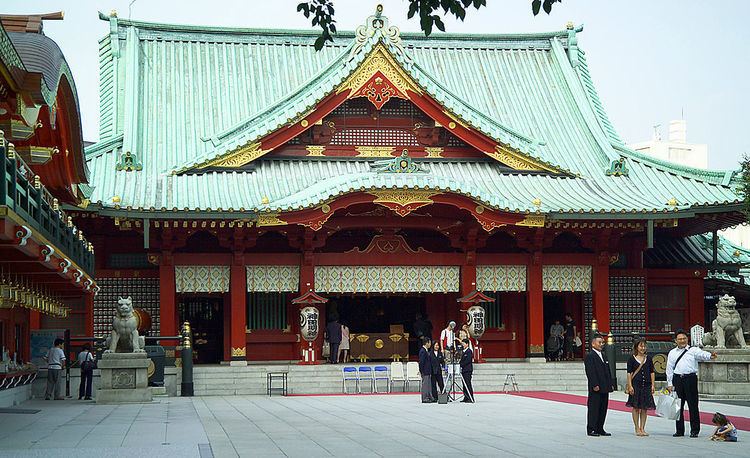Founded 730 | Phone +81 3-3254-0753 | |
 | ||
Website www.kandamyoujin.or.jp/english/top.html Similar Yushima Tenman‑gū, Tokyo Daijingu, Hie Shrine, Yushima Seidō, Edo Castle Profiles | ||
Love live shrine idol school project in akihabara kanda shrine with nihongogamer
Kanda Shrine (神田明神, Kanda-myōjin, formerly 神田神社 Kanda-jinja), is a Shinto shrine located in Chiyoda, Tokyo, Japan. The shrine dates back 1,270 years, but the current structure was rebuilt several times due to fire and earthquakes. It is situated in one of the most expensive estate areas of Tokyo. Kanda Shrine was an important shrine to both the warrior class and citizens of Japan, especially during the Edo period, when shogun Tokugawa Ieyasu paid his respects at Kanda Shrine.
Contents
- Love live shrine idol school project in akihabara kanda shrine with nihongogamer
- Kanda shrine tokyo 4k ultra hd
- History
- Architecture
- Enshrined Kami
- Festivals
- References
Kanda shrine tokyo 4k ultra hd
History
Kanda Shrine was first built in the second year of the Tenpyō Era (730 AD), in the fishing village of Shibasaki, near the modern Ōtemachi district. In order to accommodate the expansion of Edo Castle, the shrine was later moved to the former Kanda ward in 1603, then moved once again to its modern site on a small hill near Akihabara in 1616. The shrine has been rebuilt and restored many times. The current structure was destroyed in the 1923 Great Kantō earthquake and rebuilt in 1934 with concrete, and thus survived the Tokyo firebombing of World War II, unlike many of Japan's historical structures. Restoration is being done on Kanda Shrine, and work continues today.
Due in part to the proximity of the present-day Kandamyoujin shrine to Akihabara Electric Town, the shrine has become a mecca for the technophiles who frequent Akihabara. The Kandamyoujin shrine sells talismans specifically for blessing electronic devices against the types of harm that could come to them.
Architecture
The two-storey main gate, Zuishin-mon (隨神門), marks the entrance to Kanda Shrine. Zuishin-mon was reconstructed in 1995 with cypress wood, and is built with an irimoya styled roof. The shrine building is constructed in the Shinto style of Gongen-zukuri. It is painted vermilion, and decorated with gold and lacquered interiors. Many sculptures of its enshrined kami can be found on the building grounds.
Enshrined Kami
The three major kami enshrined are Daikokuten, Ebisu, and Taira no Masakado. As Daikokuten and Ebisu both belong to the Seven Gods of Fortune, Kanda Shrine is a popular place for businessmen and entrepreneurs to pray for wealth and prosperity.
Taira no Masakado however, was a samurai who rebelled against the Heian government, and was later elevated to the status of kami out of reverence. He is an important figure in the shrine's history. After his death in 940, his head was separated from his body and delivered to the Shibaraki area, near the shrine's location today. Locals who respected his defiance enshrined him in Kanda Shrine, and his spirit is said to watch over the surrounding areas. It was rumored that when his shrine fell into disrepair, Masakado's angry spirit wrought natural disasters and plagues upon the nearby lands. It is also said that shogun Tokugawa Ieyasu felt uncomfortable to have his castle built close to such a powerful spirit, and so decided to move Kanda Shrine to its modern location.
During the Meiji period, the emperor was faced with public pressure to include Kanda Shrine in the Tokyo Ten Shrines (東京十社, Tokyo Jissha), but hesitated to do so because of the shrine's association with Masakado, who was seen as an anti-government figure. This was temporarily resolved by removing Taira no Masakado as an enshrined kami. However, Masakado's spirit proved so popular amongst the commoners, that it was symbolically returned to the shrine after WWII.
Festivals
Kanda festival (Kanda matsuri) is one of the three major Shinto festivals in Tokyo, started in 1600 by Tokugawa Ieyasu to celebrate his decisive victory at the battle of Sekigahara. At the time, the festival was important enough to be named a state festival, and its highly decorated mikoshi were paraded down the main streets and into Edo castle so that even the shogun could observe the celebrations. Today it is held in honor of the enshrined kami, and celebrated around May 15 of every odd year.
Daikoku festival is also held at Kanda Shrine in January.
